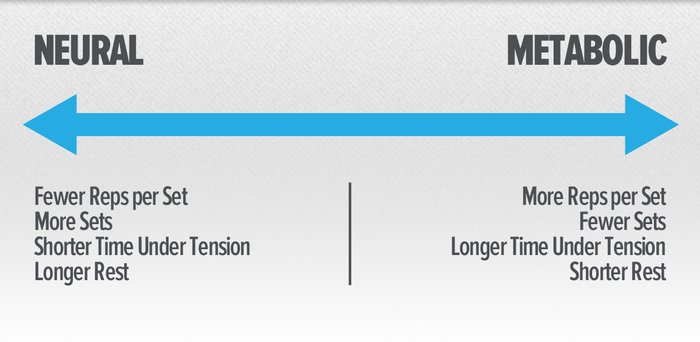Bodybuilders and strength athletes stop making progress for one reason: They stop coercing their body to adapt. Note how I intentionally use the word coerce, not a connotatively weaker action verb like force. The reason is that once you've been in the training game long enough, your body grows wiser and you realize that you can't simply force it to do anything anymore.
When you continue to push and grunt with no concrete strategy other than "hard work," you get injured or beat-up. Few things devour reasonable progress faster than what we'll call "middle ground" training. That is, always training with the same set or rep scheme and with the same intensity. If you default to training in the 8, 10, or 12 rep range, I hate to break it to you, but your growth is simply wallowing in no-gain's land.
Fortunately, there are tools in the training toolbox that will sharpen up your training. Let's start with a brief overview and then move on to how these can be applied to your own programming to maximize growth and development.
The Neural-Metabolic Continuum
The first order of business is to focus on a key element of training: The neural-metabolic continuum. It's a fancy term that allows you to understand whether you actually work your muscles or central nervous system (CNS), based on key variables. For the sake of brevity, here's a visual breakdown of what it looks like.

Before your eyes glaze over, let me explain. If you're chasing more metabolic (i.e. hypertrophic) gains, your, say, squatting program might look something like this:
- 4 sets of 10 repetitions
- Tempo: 3 seconds down, no pause in the bottom, 1 second up
- 60-90 seconds rest between sets
On the other end of the spectrum, where you might be chasing more neural (i.e. strength) gains, your program might more resemble this:
- 5 sets of 3 repetitions
- Tempo: As fast as possible
- 3-5 minutes rest between sets
Are we clear on the layout of the neural-metabolic continuum? Good, now let's look at why you need to spend time in both ends (and not the straight middle) to maximize your growth and development.

Deadlift
The Case For High Reps
By now, it's probably ingrained in you that you need to perform high reps per set (I'm looking at you, bodybuilders). Let me clarify that I define high reps to dawdle in the 8-12 rep range but could be as low as 6 reps per set.
There shouldn't be anything really earth-shattering here. If you train with high reps, your goal is to build a bigger muscle.
Some folks call this "structural hypertrophy" since the higher rep sets allow you to focus primarily on the muscles themselves. They also lend themselves to fewer total sets per exercise. By virtue of slowing down the movement, coupled with the sheer amount of reps you do per set, you're going to increase time under tension, which is a necessary stimulus for hypertrophy. No doubt, gains in strength will come along for the ride, but increases in muscular growth will outpace the increases in strength.
But what happens if you spend all your time here? Quite simply, your body will adapt to your training in this rep range if you continue it for extended periods of time. Furthermore, training in that zone will ultimately limit the amount of intensity you can use as well.
Do high-rep sets (15, 20, or more reps per set) have a place in programming? Sure, but they're probably the exception rather than the rule.
The solution here is clear: Focus on getting stronger! This brings me to my next point...

The solution here is clear: focus on getting stronger!
The Case For Low Reps
High reps deliver big gains, right? Well, low reps have a place, too!
The low-rep zone can be defined as anything between 1 rep with near-maximal effort and 5 reps in a set. They're often viewed as being geared more for powerlifting or Olympic lifting, but if you really want to make high-threshold motor units work, you will need to push some serious weight!
This focuses on making your nervous system more efficient. If you switch from sets of 10 to sets of 3, you coerceyour body to unfamiliar, shocking stressors, especially since low rep ranges encourage the use of much heavier weights. Every movement requires more "tightness" and a more intense focus. Further, more motor units and muscle fibers are recruited, and your body gets better at turning off antagonists (or opposing muscle groups) as well.
The result is that you'll get jacked, but in a slightly different way. Since the goal is more on strength, your body composition will greatly differ from someone who performs exclusively high-rep sets. Powerlifters are strong as hell and can move jaw-dropping weight, but probably lack a bit of the size and definition of a well-trained bodybuilder.
The Perfect Combination
So if high reps promote hypertrophy and low reps facilitate strength increases, then in theory, the marriage of both rep schemes will bring forth muscular and strength development worthy of the Greek gods.
You need to spend dedicated periods of time in both the high-rep and low-rep ranges to maximize your development. High reps build muscle and connective tissue strength, and give your body respite from the grind of low-rep sets, too. Similarly, low-rep sets build neuromuscular and CNS efficiency. When you become more efficient and then go back to your big lifts, you can use even more weight than before, because you're just that much more efficient and effective.
As an example of what I often do with physique-focused clients, I break down their set-rep schemes into one of two categories:
- High rep: 8-12 repetitions per set
- Low rep: 4-8 repetitions per set
These aren't hard-and-fast rules. There may be times when even higher reps (15-20) could be used. On the flipside, there are other times when you may want to push the weight and work in the 1-5 rep range.
The biggest benefit from switching between these two ranges is that you'll constantly coerce (there's that word again) your body to adapt, to grow, and to improve.
Can't I Just Train Everything At Once?
I know some people really like undulating periodization, in which you hit different set-rep schemes on different days of the week.

If this is you, perhaps your training looks something like this:
- Monday: 3 sets of 10 reps
- Wednesday: 5 sets of 5 reps
- Friday: 10 sets of 3 reps
With this weekly program, you hit everything in one training week, thinking it's smart, efficient training. This is true if you're newer to lifting or have never tried a protocol like this before. However, as you get more and more advanced, this type of scenario won't work nearly as well since you're sending multiple mixed messages to your body.
Monday's workout would tell your body it's time to get big, but then Wednesday's workout will kick your body into a bit of strength mode. Finally, Friday's workout will run counter to Monday's and place the emphasis on raw strength. What is a confused body to do?! As you become more proficient, you have to dial up the focus and be the orchestrator to your symphony of muscles (and thus, training).
It's kind of why an elite level sprinter can't simply wake up one day, decide to run a marathon, and hope to be awesome at both distances.
While I'm saying that you need to spend time on both ends of the neural-metabolic continuum, you need to have some patience and zero-in your efforts on one at a time. The general rule is to spend at least 4-6 weeks focusing on one end before you even think about heading to the other.
The Final Step: Autoregulation
Hopefully, you're now alternating between periods of high-rep and low-rep training—awesome! The next step is to alternate the level of intensity over the course of the training cycle. Think of the following quote: "A peak is surrounded by two valleys." You can't expect to go at 110 percent intensity every time you train. You'll only burn yourself out. Layer-in days of high intensity combined with days of low intensity.
The astute reader (you!) might inquire about whether simply wavering between high and low rep ranges might already serve this purpose. It does in a rather unrefined way. Here's an example of how I'll set my intensity within a training month:
- Week 1: 4 sets of 5 reps @70%
- Week 2: 5 sets of 5 reps @80%
- Week 3: 4 sets of 3 reps @75%
- Week 4: 3 sets of 5 reps @85%
As you can see, I'm not trying to move the same weights or loads on a week-to-week basis.
In week 1, I build a base and get a good weight to build my base from. In week 2, I push the limits of my volume. In week 3, I deload. Basically, that means I lower the intensity and volume to make it an "easier" work week, allowing my body to recover and supercompensate. Finally, in week 4, I go for broke with regard to my intensity. Try using this for your squat sometime—it works great!

You can't expect to go at 110 percent intensity every time you train. You'll only burn yourself out.
You could also do something far simpler, which yields amazing results when you just get started:
- Week 1: 3 sets of 10 reps @70%
- Week 2: 3 sets of 8-10 reps @75%
- Week 3: 3 sets of 8 reps @80%
- Week 4: 2 sets of 8 reps @70-75%
In this example, I use a stair-step approach to prepare you for week 3. After that, you deload and get ready to run the cycle again on week 5.
With these examples, the point I'm driving home is that you can't go hard every single week. Instead, "wave" your intensity and build up to a series of big workouts, then back off to allow your body time to recover.
It's All About Smarter Training
If you want to get the most out of your training, you not only need to work hard, but you need to work smart. By training on both ends of the neural-metabolic continuum and incorporating undulating waves of intensity into your training cycle, you'll not only see better results but you'll incur fewer bumps and bruises along the way.

